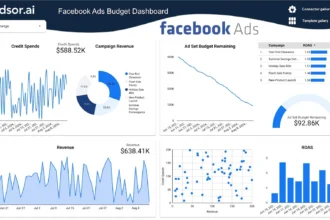What Is the Work of Performance Marketer? Here’s What Actually Drives Results And Revenue
Let’s be honest—digital marketing today is a noisy, overcrowded jungle. Everyone’s bidding for clicks, churning out content, and praying to the algorithm gods. But while most brands are guessing their way through ad budgets, there’s a different breed of marketer quietly driving 10x returns and scaling growth like clockwork.
That’s the performance marketer.
So, what is the work of performance marketer, really?
It’s not just running Facebook Ads or launching A/B tests (although that’s part of it). It’s the art and science of driving measurable, ROI-focused growth through data, strategy, and relentless optimization. These are the marketers who turn dollars into results, not just impressions. They don’t guess—they analyze, automate, and scale.
In a world where every click, conversion, and customer counts, performance marketing isn’t just a skill set. It’s the engine room of modern business growth.
This article breaks it down—from what a performance marketer actually does day-to-day, to the tools they swear by, and the exact strategies behind those “how-the-hell-did-they-do-that” results. With real stats, case insights, and a peek into the minds of today’s top performance marketers, you’re about to get a masterclass in measurable marketing.
Also Read: Is facebook Ads Performance Marketing?
Let’s answer the question for real: What is the work of performance marketer?
Spoiler: It’s more powerful than you think.
Understanding the Role: What Is the Work of Performance Marketer?
At its core, the work of a performance marketer revolves around one key principle: if it can’t be measured, it doesn’t matter.
So, what is the work of performance marketer in practical terms? It’s a strategic mix of digital advertising, analytics, creative alignment, and business acumen—all designed to generate measurable, scalable results.
Unlike traditional marketers who often prioritize brand awareness or long-term positioning, performance marketers are laser-focused on conversions, whether that’s a product sale, lead capture, app install, or webinar signup.
But don’t confuse “performance” with just paid ads—it’s a broader discipline. Performance marketers own the full funnel, from driving cold traffic with smart targeting, to nurturing conversions through data-backed optimization.
It’s All About Outcomes
Here’s what separates performance marketing from the noise:
- Every campaign is tracked in real-time.
- Every dollar spent must justify its existence via data.
- Decisions are made based on performance metrics—not hunches.
In other words, performance marketers are part creative strategist, part analyst, and part growth architect.
Key Metrics Performance Marketers Live By:
To fully grasp what is the work of performance marketer, you need to understand the metrics they breathe daily:
- CPA (Cost per Acquisition) – how much it costs to acquire a customer
- CTR (Click-Through Rate) – how enticing your ad is to your audience
- ROAS (Return on Ad Spend) – the revenue generated per dollar spent on ads
- LTV (Customer Lifetime Value) – how valuable a customer is over time
- CVR (Conversion Rate) – the percentage of users who take the desired action
These KPIs aren’t just numbers—they’re the heartbeat of every decision a performance marketer makes.
The Performance Marketer’s Mandate
Performance marketers sit at the intersection of:
- Digital strategy
- Data analytics
- Creative execution
- Revenue generation
They’re not just launching campaigns—they’re designing ecosystems where paid media, landing pages, audience data, and content all work together toward one goal: measurable success.
So, when someone asks: “What is the work of performance marketer?” The real answer is this:
A performance marketer is the growth engine behind your business—the one translating digital chaos into clean, profitable outcomes.
6 Core Responsibilities of a Performance Marketer
To truly understand what is the work of performance marketer, you need to zoom in on the trenches—the day-to-day, the dashboards, and the decision-making that directly impacts a company’s bottom line.
Performance marketing isn’t a one-note job. It’s an ever-evolving role built on strategy, precision, testing, and adaptability. Below is a breakdown of the core responsibilities that define the craft:
1. Strategy Development: Setting the Map Before the Mission
Before a single ad goes live, a performance marketer is already deep into audience analysis, platform research, and KPI design. This isn’t guesswork—this is about aligning ad spend with the brand’s north star metrics.
Key actions include:
- Defining buyer personas and intent signals
- Mapping customer journeys across platforms
- Choosing the right channels: Google Ads, Facebook, LinkedIn, YouTube, TikTok
- Setting goals: CPA, ROAS, LTV, Conversion Rate
Case in point: A fintech startup targeting Gen Z used TikTok and YouTube Shorts for upper-funnel awareness, while retargeting users with intent-driven Meta Ads—dropping their CPA by 33% in 60 days.
2. Campaign Execution & Management: The Daily Grind
Once the strategy is locked, performance marketers shift into execution mode. This is the pulse of their workflow—launching, monitoring, and optimizing campaigns on the fly.
Tasks include:
- Writing briefs for creatives and copy
- Building ad sets and testing formats (carousels, videos, dynamic ads)
- Setting targeting rules and lookalike audiences
- Monitoring campaigns daily for trends and anomalies
Smart marketers don’t just “set and forget”—they iterate constantly. A/B testing headlines, swapping creatives, and adjusting bids are daily rituals.
3. Data Analytics & Reporting: Where the Magic Actually Happens
What is the work of performance marketer without data? Flat-out guesswork.
Performance marketing is data-driven to the bone. This means deep diving into analytics to:
- Track every click, conversion, and dollar spent
- Segment results by device, audience, geography, and time
- Identify trends and make data-informed pivots
- Build dashboards in tools like Google Data Studio or Tableau
Pro Tip: The best performance marketers treat data like a story—every chart has a narrative, every spike a reason.
4. Budget Management: Doing More with (Sometimes) Less
Performance marketers are custodians of the marketing wallet. Whether managing $5,000/month or $500,000/month, the goal is the same: maximize return per dollar.
Key responsibilities:
- Allocating budget by channel based on historical data
- Shifting spend mid-campaign based on real-time ROAS
- Forecasting outcomes to justify budget increases
- Avoiding budget burn via pacing and rules-based bidding
Stat: Marketers who use dynamic budget allocation see up to 25% better performance than those using fixed budgets (La Fosse, 2024).
5. Continuous Optimization: A/B Test. Learn. Repeat.
In performance marketing, “set it and forget it” is a death sentence. The job demands constant iteration:
- Testing landing pages, ad copy, CTAs, audience segments
- Leveraging heatmaps and scroll data to tweak user experience
- Running multivariate tests to isolate high-converting variants
- Retesting as platform algorithms evolve
A great performance marketer doesn’t ask “What worked?”—they ask “What could work better tomorrow?”
6. Cross-Functional Collaboration: The Team Sport Side of the Job
No performance marketer works in a silo. To truly move the needle, they must:
- Align with content teams to ensure messaging consistency
- Sync with designers for on-brand, high-impact visuals
- Partner with product and dev teams for tracking & pixel setup
- Collaborate with email, SEO, and automation teams for funnel continuity
Stat: 74% of high-performing campaigns result from close collaboration between performance and creative teams (MarketingProfs, 2023).
All of this combined is what makes the work of performance marketer so vital—they’re not just ad buyers; they’re strategic operators who blend creativity, technology, and analytics to drive results businesses can actually count on.
Collaboration with Cross-Functional Teams
If you still think performance marketers just run ads in a dark corner of the office, think again.
A high-impact performance marketer is as much a team integrator as they are a strategist. Their effectiveness relies on their ability to orchestrate moving parts across marketing, sales, design, and product—ensuring everything aligns to drive bottom-line growth.
So when asking, “What is the work of performance marketer?”, don’t overlook this crucial (and often underestimated) function: cross-functional collaboration.
Why Collaboration Matters
Here’s the truth: No performance campaign—no matter how well-targeted or analytically sound—can succeed in a vacuum.
Your ads are only as strong as:
- The creatives that catch the eye
- The landing pages that convert
- The brand narrative that earns trust
- The customer journey that follows through
Without alignment across teams, even the most data-driven campaign becomes a leaky bucket.
Who Does the Performance Marketer Work With?
Let’s break down the departments and how a performance marketer links with each:
Creative Team
- Why: To develop compelling ad copy, graphics, and video content that matches platform best practices
- How: Through briefs, feedback loops, and iterative testing
- Example: Requesting multiple thumbnail variants for YouTube pre-roll ads to A/B test impact on CTR
Content & SEO Team
- Why: To ensure messaging is aligned across ads, blog posts, landing pages, and organic content
- How: Sharing keyword insights, performance data, and funnel needs
- Example: Coordinating blog CTAs to match retargeting campaigns for smoother lead-gen flow
Product & Engineering Teams
- Why: To set up accurate event tracking, implement pixels, and build optimized landing pages
- How: Via UTM coordination, custom conversion events, and page speed tweaks
- Example: Collaborating on a post-signup thank-you page optimized for upsell tracking via GA4
CRM / Email Marketing Teams
- Why: To sync retargeting and remarketing with drip campaigns and lead nurture flows
- How: Aligning custom audiences with segmented email lists
- Example: Serving Facebook ads only to leads who clicked—but didn’t open—the last email campaign
Sales Teams
- Why: To align lead quality, follow-up timing, and conversion expectations
- How: Weekly syncs, lead scoring feedback loops, and real-time performance dashboards
- Example: Feeding high-intent leads from a paid LinkedIn campaign directly to SDRs via HubSpot
Pro Insight: The best performance marketers speak multiple “languages”—design, dev, sales, and strategy. They’re translators of data into action across the org.
Collaboration = Faster Iteration
When cross-team synergy is strong, performance marketers can:
- Get creatives faster
- Test more landing pages
- Improve data quality
- Respond to trends in real-time
- Scale winners quicker
And that’s the name of the game.
So again, what is the work of performance marketer? Among other things—it’s being the central nervous system of the entire digital operation, keeping everyone synced, data-informed, and revenue-focused.
4 Tools and Technologies Every Performance Marketer Must Master
What is the work of performance marketer? In a word: leverage. Performance marketers don’t just rely on gut instinct or legacy tactics—they leverage tech stacks that allow them to scale, automate, and optimize faster than ever before.
Also Read: What is The Difference Between Paid Ads and Performance Marketing?
In this section, we break down the mission-critical tools that form the digital backbone of performance marketing. From ad platforms to analytics dashboards, these are the instruments that separate average from elite.
Digital Advertising Platforms: Where the Magic Starts
Performance marketers spend most of their day deep inside these platforms—optimizing campaigns, analyzing real-time performance, and scaling what works.
| Platform | What It’s For | Why It Matters |
| Google Ads | Search, Display, YouTube, Shopping | Still the king of intent-driven traffic |
| Meta Ads (Facebook/Instagram) | Paid social across high-traffic placements | Advanced audience targeting + visual storytelling |
| LinkedIn Ads | B2B lead gen and account-based marketing | Ideal for targeting professionals by job title or industry |
| TikTok Ads | Short-form creative at scale | Explosive reach and low CPMs—great for DTC & mobile apps |
| X (Twitter), Pinterest, Reddit | Niche targeting | Great for supplementing specific audiences or trends |
Tip: The best performance marketers go channel agnostic—testing widely, then doubling down on what scales profitably.
Analytics & Reporting Tools: Where Strategy Meets Reality
Performance without data is just noise. These tools empower marketers to see beyond the surface and understand what’s truly driving ROI.
| Tool | What It’s For |
| Google Analytics / GA4 | Website traffic, behavior, and conversion paths |
| Google Data Studio | Real-time dashboards for performance KPIs |
| Looker / Tableau / Power BI | Advanced data visualization for enterprise campaigns |
| Mixpanel / Amplitude | Behavioral insights, cohort tracking, and event flows |
| Hotjar / Crazy Egg | Heatmaps and session recordings for landing page UX insights |
Testing & Experimentation Tools: For Rapid Optimization
Performance marketing thrives on iteration. These tools allow for controlled experimentation that can make or break a campaign.
| Tool | Use Case |
| VWO / Optimizely | A/B and multivariate testing for web pages and CTAs |
| Google Optimize | Lightweight split testing connected to GA4 |
| Unbounce / Instapage | Rapid landing page testing without dev resources |
Example: A B2C ecommerce brand saw a 17% lift in conversions by simply testing a red CTA button versus a green one on mobile. No new ad spend—just better UX.
CRM & Retargeting Ecosystem: Keeping the Funnel Tight
Once a user clicks, the performance marketer’s job isn’t done. CRM and retargeting tools ensure no lead gets left behind and every touchpoint adds value.
| Tool | Role |
| HubSpot / Salesforce / Zoho | CRM, lead management, automation |
| Klaviyo / Mailchimp | Email flows triggered by behavior or campaign source |
| Triple Whale / Northbeam | Advanced attribution and performance visibility |
| Segment / Tealium | Customer data platforms (CDPs) to unify audience data |
Why it matters: Performance marketers use CRM data to build lookalike audiences, exclude converters, and personalize retargeting ads. That’s how you spend smart.
Honorable Mentions: The Unsung Heroes
- Slack + Asana / Trello – For campaign management and inter-team sync
- Figma / Canva / Adobe Creative Cloud – For ad creative collaboration
- ChatGPT / Jasper / Copy.ai – For rapid copy testing and variant generation
Real Talk: It’s Not About Having Every Tool—It’s About Using the Right Ones Well.
“A great performance marketer isn’t the one with the biggest tech stack—it’s the one who knows which 3 tools to use, when to use them, and how to pull 10x results from each.”
So again, when we ask what is the work of performance marketer, we’re also asking: Can they choose the right tool for the right metric at the right time? Because in this game, precision beats power.
6 Key Skills That Set Elite Performance Marketers Apart

You can know the tools. You can memorize the acronyms. But if you don’t have the skill set to adapt, analyze, and act fast, the tools won’t save you.
So what is the work of performance marketer—really? It’s a mix of hard skills, soft power, and instinct sharpened by data. Below are the traits that turn good marketers into revenue-driving machines.
1. Analytical Thinking
At the heart of performance marketing lies a constant question:
“What is this data trying to tell me?”
Top-tier performance marketers are obsessed with metrics—and not just surface-level ones. They know how to:
- Read trends beyond CTRs and CPAs
- Diagnose why a campaign plateaued or spiked
- Run attribution models to trace real revenue impact
2. Creative Problem-Solving
Data tells you what’s happening. Creativity tells you how to fix it.
Performance marketers aren’t just spreadsheet warriors—they’re idea machines. When ads underperform or platforms shift, they:
- Reframe audience targeting
- Spin up new offer angles or hooks
- Collaborate with creatives to A/B test fresh visuals
Example: A mid-funnel ad campaign flatlined—until the marketer swapped a generic value prop with a bold testimonial overlay. CTR jumped 22% overnight.
3. Agility & Speed of Execution
Markets shift. Algorithms change. Platforms glitch.
Elite performance marketers don’t panic—they pivot.
They can:
- React fast to performance dips
- Implement feedback loops in real time
- Launch MVP tests within 24 hours
Because in this field, slow equals sunk.
4. Technical Competency
You don’t have to code like a full-stack dev—but you do need to be tech-fluent.
Great performance marketers understand:
- How tracking pixels work
- What GA4 events actually measure
- How to QA UTMs, tags, and audience rules
- How APIs and integrations affect data flow
Pro Tip: Know your tracking stack like your playlists—intimately and on repeat.
5. Communication & Reporting Skills
Let’s be honest—data is only valuable if you can explain it clearly.
Performance marketers often report to C-suite executives, brand managers, or even clients. That means:
- Distilling complex numbers into simple insights
- Telling the story behind the performance
- Suggesting action steps backed by confidence, not jargon
Example: “Our Meta CPMs rose by 12% last week, but ROAS held steady due to a tighter remarketing loop and stronger mid-funnel creative.”
6. Curiosity and Relentless Learning
Algorithms evolve. Audience behavior shifts. Platforms get overhauled.
To stay competitive, elite performance marketers are constant learners. They:
- Follow the data and test new hypotheses weekly
- Read platform updates like news headlines
- Upskill with courses, certifications, and peer insights
Stat: 68% of marketers who hit 5x ROAS or higher invest in continuous education at least once per quarter.
Bonus Trait: Obsession With ROI
Above all else, great performance marketers have one unshakable trait:
They care deeply about the business outcome.
Every campaign. Every test. Every tweak. It’s not about vanity metrics—it’s about profit, pipeline, and performance that actually moves the business forward.
So if you’re still wondering “What is the work of performance marketer?”—add this to the list:
It’s having the mindset of a scientist, the soul of a creative, and the drive of a founder.
Real-World Success Stories: What Performance Marketers Actually Achieve
So far, we’ve unpacked the strategies, skills, and tools. But what does all this actually look like in action? What is the work of performance marketer when it drives real revenue, saves budgets, and scales businesses?
This section isn’t just inspiration—it’s validation. These success stories show how performance marketers deliver results you can take to the boardroom.
E-commerce Brand Cuts CAC by 41% in 6 Weeks
The Challenge: A mid-size fashion retailer was bleeding budget on Facebook Ads, with a Cost per Acquisition (CAC) of $52 and stagnating sales.
What the Performance Marketer Did:
- Introduced segmented ad sets based on purchase intent signals
- A/B tested 7 video creatives optimized for mobile
- Integrated Klaviyo email flows with retargeting audiences
The Result:
- CAC dropped to $31
- ROAS jumped from 2.1x to 4.8x
- Email-assisted conversions increased 39%
Takeaway: Smart segmentation + multi-channel synergy = lower cost, higher return.
EdTech Startup Achieves 7x ROAS Using TikTok + LinkedIn
The Challenge: A SaaS platform selling to both students and educators needed to scale fast but struggled with platform-channel fit.
What the Performance Marketer Did:
- Created two distinct funnels: TikTok for Gen Z users, LinkedIn for academic buyers
- Ran split tests on CTA copy that matched platform tone
- Used heatmaps to improve drop-off points on the pricing page
The Result:
- 7x ROAS on TikTok (with influencer UGC)
- 5.3x ROAS on LinkedIn using lead gen forms
- Trial-to-paid conversion rate improved 21%
Performance marketing isn’t about choosing one channel—it’s about making each one work for the audience it attracts.
HealthTech Brand Uses Dynamic Retargeting to Reclaim Lost Leads
The Challenge: A telemedicine provider was losing 60% of users at the checkout stage. Ad campaigns were bringing in traffic, but conversion rates were tanking.
What the Performance Marketer Did:
- Implemented dynamic retargeting across Meta and Google Display
- A/B tested urgency-driven CTAs like “Your prescription expires in 24 hours”
- Adjusted bidding strategies to favor high-intent past visitors
The Result:
- Checkout abandonment dropped by 30%
- Revenue from remarketing doubled in under 3 weeks
- CPA reduced by 26% on returning users
Sometimes, the win isn’t more traffic—it’s making the traffic you already paid for count.
B2B SaaS Scales Enterprise Leads with Predictive Budget Allocation
The Challenge: A SaaS company serving enterprise clients was overspending on low-value leads and underinvesting in high-converting channels.
What the Performance Marketer Did:
- Built a predictive model using Google Data Studio + Salesforce data
- Shifted 60% of spend to underutilized high-LTV channels (YouTube, Programmatic)
- Collaborated with sales to refine MQL and SQL definitions
The Result:
- Lead quality increased by 44%
- SQL-to-Customer rate doubled
- Annualized pipeline grew by $3.2M
Elite performance marketers aren’t just media buyers—they’re growth architects.
Pattern Recognition: What All These Wins Have in Common
Across verticals and budgets, great performance marketing always comes down to:
- Clear KPIs tied to revenue
- Deep understanding of the funnel
- Creative + data playing on the same team
- Relentless testing and optimization
So next time someone asks “What is the work of performance marketer?”, don’t just talk tactics. Show the impact. Show the lift. Show the real growth they bring to the table.
Why Performance Marketing Matters in 2025 and Beyond
If you’re still wondering what is the work of performance marketer, zoom out.
Because performance marketing goes beyond campaigns, it’s more about building a growth system that thrives on clarity, accountability, and results. And in 2025’s hypercompetitive landscape, every click, scroll, and second counts.
Accountability Is the New Marketing Currency
The days of vague impressions and gut-feel spending are long gone. Today, every stakeholder—from CMO to CFO—wants receipts.
Performance marketing delivers:
- Real-time data on ROI
- Campaigns optimized for outcomes, not optics
- Predictable pipelines and scalable revenue growth
Stat: 89% of businesses say marketing accountability is now a top-five C-suite priority (Gartner, 2025).
Speed, Scale, and Smart Spend
Performance marketing is built for the now. Whether you’re launching a product, scaling a startup, or entering a new market, performance marketers make it happen fast—without blowing your budget.
- Launch A/B tests within hours
- Reallocate ad spend in real time
- Scale what works, kill what doesn’t—no ego, just efficiency
Platforms like Meta and Google Ads are now AI-enhanced by default, but human optimization is still what gives your brand the edge.
The Full-Funnel Advantage
Modern consumers don’t follow linear paths. They bounce between devices, channels, and touchpoints. Performance marketers are uniquely equipped to:
- Track user behavior across the full funnel
- Optimize each stage of the journey
- Ensure no opportunity leaks through the cracks
From awareness to purchase—and beyond—they engineer the journey with precision.
Future-Proofing Through Data Mastery
Let’s be real: AI isn’t coming. It’s already here. And in this AI-powered world, the brands that win are the ones with:
- Clean data
- Smart targeting
- Predictive analytics
- Human oversight layered with tech efficiency
Performance marketers sit at the center of this evolution—driving decision-making, not just serving it.
Gartner predicts that by 2027, 70% of high-growth companies will have at least one dedicated performance marketing strategist at the leadership level.
Why Your Business Can’t Afford to Ignore This
Performance marketing isn’t a trend. It’s not a tactic. It’s a mindset—one that puts results first, cuts waste, and scales smart.
So, what is the work of performance marketer?
It’s delivering measurable growth, predictable revenue, and continuous optimization—on repeat.
In a digital world defined by chaos and clicks, performance marketers are the calm operators. The growth architects. The ROI warriors.
And in 2025, they’re not just nice to have—they’re mission critical.
Conclusion: So, What Is the Work of Performance Marketer?
Here’s the bottom line:
Performance marketers don’t just run ads—they run results.
They are the strategists behind the spend, the scientists behind the scale, and the connectors between clicks and customers. From setting KPIs to tweaking creative mid-campaign, from analyzing heatmaps to reallocating six-figure budgets—their job is to make every dollar work harder.
In a world where marketing teams are under pressure to do more with less, the performance marketer stands out not just as a digital executor—but as a revenue operator.
So next time someone asks, “What is the work of performance marketer?”, you’ll know it’s this:
Design. Test. Optimize. Scale. Report. Repeat.
All backed by data. All tied to results. No fluff, no filler.
Frequently Asked Question: What Is the Work of Performance Marketer? — Your Top Questions Answered
What does a performance marketer do daily?
They monitor and optimize ad campaigns, test creatives and audiences, report on performance metrics like CPA and ROAS, and collaborate with teams to improve user journey and conversion rates.
Which platforms do performance marketers use most?
Google Ads, Meta (Facebook & Instagram), LinkedIn Ads, TikTok Ads, and Google Analytics are top-tier essentials. Tools like Data Studio, Hotjar, and HubSpot are also commonly used.
Is performance marketing the same as digital marketing?
Not quite. Digital marketing is a broad umbrella. Performance marketing is a results-focused subset—everything is measured, tested, and optimized for specific KPIs like leads, sales, and conversions.
What skills are needed to become a performance marketer?
Analytical thinking, creative problem-solving, A/B testing, platform fluency (Google, Meta, etc.), data literacy, and solid communication/reporting skills.
What kind of businesses benefit from performance marketing?
E-commerce brands, SaaS companies, B2B service providers, startups, healthtech, fintech—you name it. If your business depends on measurable results from digital campaigns, you need performance marketing.
How is success measured in performance marketing?
Success is measured using key performance indicators (KPIs) like:
- Return on Ad Spend (ROAS)
- Cost per Acquisition (CPA)
- Customer Lifetime Value (LTV)
- Conversion Rate
- Click-Through Rate (CTR)
Can a solo entrepreneur handle performance marketing?
Yes—but with caveats. Start lean, focus on one or two channels, and invest in learning or hiring specialists as your business scales. DIY works early on, but optimization is where real ROI lies.
Want to rank? Want to scale? Want to make every marketing dollar sweat?
Then performance marketing—and performance marketers—are your unfair advantage in 2025 and beyond.








